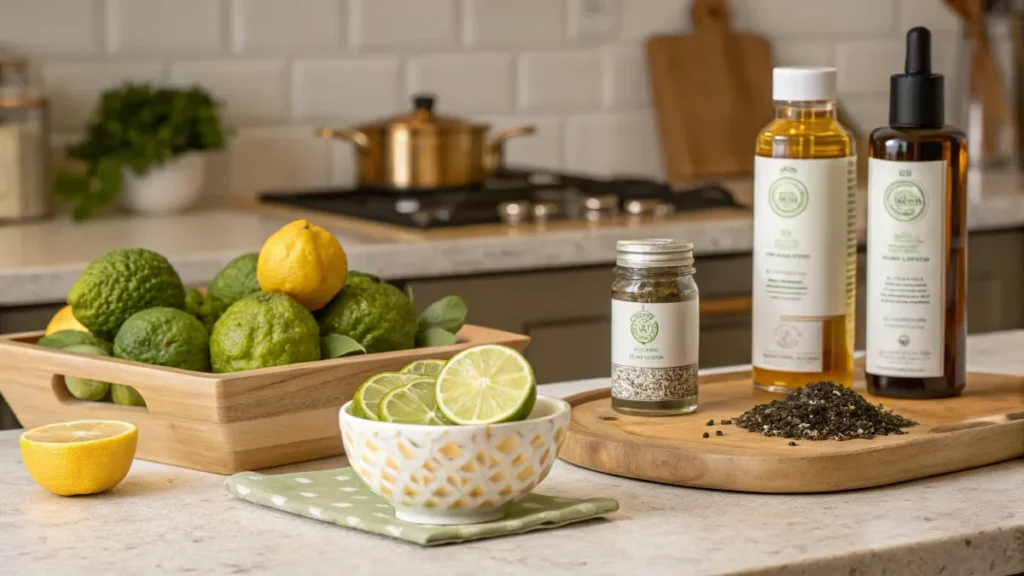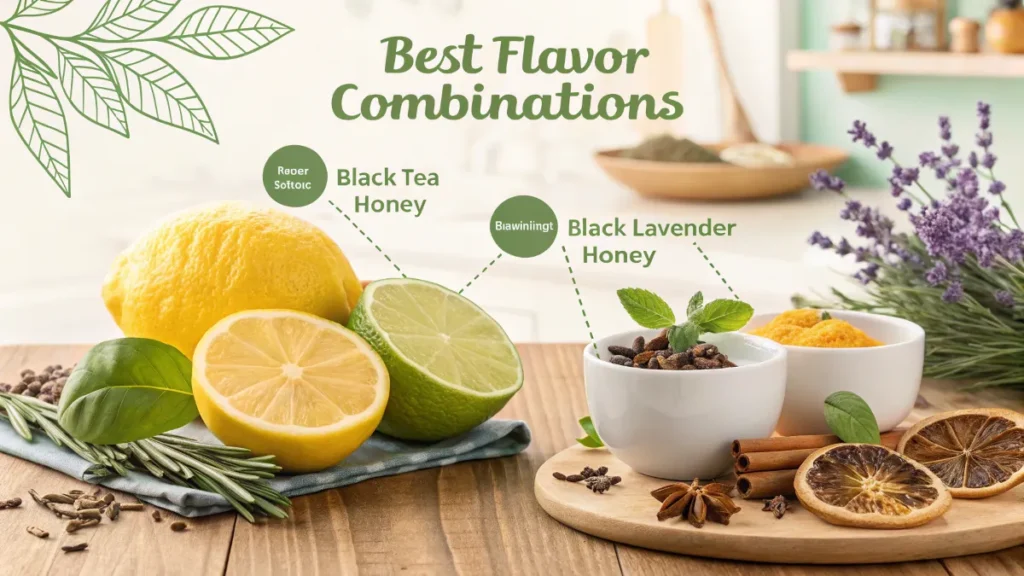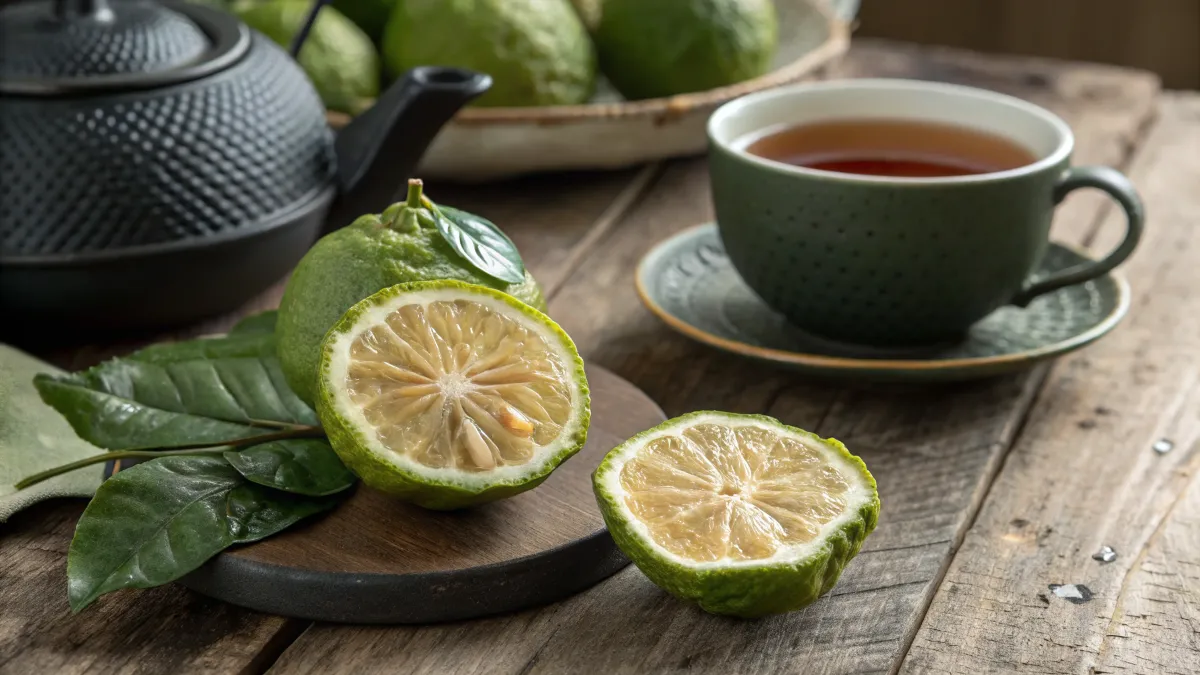Bergamot is a popular yet mysterious ingredient that has intrigued many with its unique taste and aromatic profile. You may have come across it in Earl Grey tea, fancy desserts, or even in perfumes. But what does bergamot flavor taste like? This article dives deep into the essence of bergamot, exploring its origins, uses, flavor profile, and culinary pairings. You’ll discover why this citrus fruit stands out and how it adds a special touch to various foods and beverages. Let’s break it down, starting with understanding bergamot itself.
Table of Contents
Understanding Bergamot as an Ingredient
Bergamot isn’t as common as oranges or lemons, so it often raises curiosity. Let’s explore what makes this citrus fruit special.
What Is Bergamot?
Bergamot is a fragrant citrus fruit, typically the size of an orange but with a yellow or green color similar to a lime. It’s believed to be a hybrid of lemon and bitter orange, which gives it its distinctive taste. The fruit is most well-known for its essential oil, which is extracted from the peel and used in perfumes, teas, and recipes.
Origin and Cultivation of Bergamot
The name “bergamot” is derived from Bergamo, a town in Italy where the fruit was first commercially cultivated. Today, bergamot is mainly grown in the Calabria region of southern Italy, where the soil and climate are ideal for producing the best-quality fruit. It’s also cultivated in parts of France and Turkey.
Bergamot thrives in coastal areas with mild winters and long summers. Its flowers bloom in early spring, while the fruit is harvested between November and March.
Common Uses of Bergamot in Food and Beverages

Bergamot’s strong aroma and flavor make it a sought-after ingredient in many dishes and drinks. You’ll often find it in:
- Earl Grey tea: Bergamot oil is what gives this famous tea its floral, citrusy scent.
- Baked goods: From cakes to cookies, bergamot adds a fresh, tangy twist.
- Marmalades and jams: Its bitterness blends well with sugar, creating delicious spreads.
- Cocktails: Mixologists love bergamot for its ability to enhance drinks with a zesty aroma.
Thanks to its versatility, bergamot is a beloved ingredient in both sweet and savory recipes.
The Unique Flavor Profile of Bergamot
Bergamot’s taste can be hard to describe since it blends several distinct flavors. Many people ask, “What does bergamot flavor taste like?” Let’s break it down into key characteristics.
Citrus Notes in Bergamot
Bergamot has a noticeable citrusy base, which comes from its origins as a hybrid of bitter orange and lemon. Its citrus flavor is not as sharp as a lemon’s but less sweet than an orange’s. Imagine something between zesty and slightly sour, with a mellow sweetness. This unique balance makes it stand out in teas and desserts.
Floral Undertones and Aromatics
Beyond its citrus flavor, bergamot carries floral notes that add a delicate aroma. These floral hints are why it’s often used in perfumed products like Earl Grey tea. The floral undertones are subtle but essential to its complex flavor profile. This combination of citrus and floral makes bergamot distinct from other fruits like lime or grapefruit.
Comparison to Other Citrus Fruits
If you’ve ever tasted orange, lemon, and lime, you might think bergamot would taste similar. However, it’s more refined, with a less tangy punch and more aromatic complexity. Its bittersweet profile makes it ideal for balancing rich or sweet foods without overpowering them.
For a deeper dive into how bergamot is used in recipes, check out this guide on using citrus in cooking from Allrecipes.
How Bergamot Is Used in Different Cuisines
Bergamot’s distinctive flavor makes it a favorite in various cuisines, especially in Mediterranean dishes. Its ability to add depth without overwhelming other flavors is a major reason why chefs love it.
Bergamot in Italian Cuisine
Italy is famous for using bergamot in many traditional dishes. In Calabria, where most bergamot is grown, locals use it in marmalades and sweet treats. It also appears in sauces for pasta and seafood dishes, adding brightness to the recipes. A well-known Italian favorite is bergamot-infused olive oil, which gives salads a refreshing twist.
Bergamot in Desserts and Sweets

Thanks to its floral and citrus notes, bergamot pairs wonderfully with sugar. It’s a popular ingredient in cakes, cookies, and even ice cream. Adding bergamot zest or juice to baked goods creates a light and fragrant flavor. For an easy bergamot dessert recipe, check out this citrus dessert idea from Simply Recipes.
Bergamot in Herbal Teas and Earl Grey
Perhaps the most famous use of bergamot is in Earl Grey tea. The essential oil extracted from bergamot peel gives the tea its signature floral-citrus aroma. Many herbal teas also use dried bergamot for its calming properties. The next time you sip on Earl Grey, you’ll know what gives it that unique taste!
Bergamot’s versatility means it works equally well in savory or sweet dishes. Whether enhancing pasta or flavoring a dessert, this fruit adds a layer of complexity that’s hard to replicate.
Pairing Bergamot with Other Flavors
When it comes to cooking, knowing how to pair ingredients is key. Bergamot, with its bold and complex flavor, pairs wonderfully with many other ingredients. But what does bergamot flavor taste like when combined with different foods? Let’s explore some great pairings!
Best Flavor Combinations with Bergamot
Bergamot’s unique blend of citrus and floral notes makes it versatile. It pairs well with:
- Vanilla – The sweet, creamy taste of vanilla balances bergamot’s slightly bitter undertones. Together, they create a rich flavor found in many desserts.
- Chocolate – Dark chocolate complements bergamot’s tanginess, enhancing its floral notes. Earl Grey chocolate truffles are a perfect example.
- Berries – Sweet berries like raspberries and blueberries bring out bergamot’s citrus side, making it a great addition to fruit salads or smoothies.
For more pairing ideas, you might find inspiration in our Earl Grey Cookies recipe on Charmed Recipes!
Popular Recipes Featuring Bergamot
- Earl Grey shortbread cookies – These buttery cookies are enhanced with bergamot oil or tea leaves.
- Citrus vinaigrette – A salad dressing made with bergamot juice adds brightness to leafy greens.
- Cocktails – Bergamot pairs beautifully with gin, making it a star in refreshing cocktails.
Curious about making these dishes at home? Check out similar recipes on Charmed Recipes for more citrus-infused treats!
Health Benefits and Safety of Bergamot
Bergamot isn’t just tasty it also offers several potential health benefits. But before consuming large amounts, it’s important to know about its nutritional value and any risks.
Nutritional Value of Bergamot
Bergamot is rich in antioxidants and vitamins, particularly vitamin C. Like other citrus fruits, it contains flavonoids, which help fight inflammation. Additionally, bergamot oil is known for its calming aroma, often used in aromatherapy.
Potential Health Benefits
- Heart health – Studies suggest that compounds in bergamot may help lower cholesterol levels.
- Stress relief – Many herbal teas containing bergamot, like Earl Grey, are known for their relaxing properties.
- Digestive aid – The citrus elements in bergamot may promote healthy digestion when consumed in small amounts.
Are There Any Risks in Consuming Bergamot?
While bergamot has many health benefits, it’s important to consume it in moderation. Large amounts of bergamot oil can cause sensitivity to sunlight due to its photosensitizing properties. Also, some people might be allergic to citrus fruits, including bergamot. When trying bergamot for the first time, start with small portions to see how your body reacts.
Where to Find and Buy Bergamot Products
If you’re curious about what does bergamot flavor taste like and want to experience it firsthand, you might wonder where to get quality bergamot products. Fortunately, many options are available both online and in local stores.
Types of Bergamot Products Available
Bergamot is sold in different forms, each with unique uses:
- Fresh Bergamot Fruit – Though rare, some specialty grocery stores and farmers’ markets carry fresh bergamot. You can use it to make marmalade, zest for baked goods, or fresh juice.
- Bergamot Oil – This highly concentrated oil is used for flavoring tea and desserts. It’s also a common ingredient in aromatherapy products.
- Bergamot Tea – The easiest way to enjoy bergamot is through Earl Grey tea, which is widely available in supermarkets. The distinctive flavor comes from bergamot oil added to black tea.
- Bergamot Extract or Essence – This liquid is used by bakers and chefs to add bergamot’s signature citrusy aroma to various recipes.
How to Choose Quality Bergamot Products
When buying bergamot products, always check for:
- Origin – Look for products from Calabria, Italy, known for producing high-quality bergamot.
- Ingredients – Ensure that any tea or extract lists “natural bergamot oil” rather than artificial flavoring.
- Packaging – Bergamot oil should be in dark glass bottles to prevent light from degrading its quality.
For more tips on selecting fresh ingredients, check out this guide on citrus fruits from Charmed Recipes.
Frequently Asked Questions (FAQs)
Many people are curious about bergamot’s taste, uses, and benefits. Below are some frequently asked questions, along with helpful answers.
Does Bergamot Taste Like Orange?
Not exactly. Although bergamot belongs to the citrus family, its taste is more complex than a typical orange. It has a bright, tangy flavor with floral undertones, which sets it apart. Some describe it as a mix between lemon, lime, and a hint of lavender. If you’re still wondering what bergamot flavor tastes like, try Earl Grey tea for a quick introduction.
Why Is Bergamot Used in Earl Grey Tea?
Bergamot oil adds a refreshing citrus aroma and a slightly bitter flavor to Earl Grey tea. This gives the tea its distinct taste that blends well with the boldness of black tea leaves. Over time, Earl Grey has become one of the most popular flavored teas, thanks to bergamot’s unique appeal.
How Can I Use Fresh Bergamot at Home?
There are several creative ways to use fresh bergamot:
–Zest the peel into baked goods like muffins or cookies.
–Juice the fruit to make a tangy dressing or refreshing lemonade.
–Add slices to seafood or poultry dishes for a citrusy kick.
If you’re a fan of unique flavors, you’ll love how bergamot can enhance both sweet and savory recipes.
Bergamot Flavor

Now that we’ve explored the different aspects of bergamot, you may have a clearer idea of its unique flavor. So, what does bergamot flavor taste like exactly? It’s a distinctive blend of citrus and floral notes with a hint of bitterness. Whether in Earl Grey tea, desserts, or savory dishes, bergamot adds a touch of elegance to any recipe.
Why You Should Try Bergamot
If you’ve never tried bergamot, now might be the perfect time. Its versatility in both sweet and savory dishes makes it a great addition to your kitchen. Plus, its health benefits, including antioxidants and stress relief properties, give you even more reasons to enjoy it. For those who love experimenting with new flavors, bergamot offers a world of possibilities.
Where to Start?
Begin with something simple, like a cup of Earl Grey tea, to experience the classic bergamot flavor. From there, you can try recipes using fresh bergamot or bergamot-infused oils. If you’re feeling adventurous, create your own desserts with bergamot zest for a refreshing twist.
For more delicious citrus recipes, check out Charmed Recipes and discover new ways to elevate your meals.
Cooking Tips for Using Bergamot at Home
Cooking with bergamot can be fun and rewarding if you know how to handle its strong flavor. Since bergamot has a bold taste, it’s best to use it in small amounts. This ensures that its citrusy and floral notes don’t overpower your dish.
Best Ways to Add Bergamot to Your Cooking
- Use the zest – Grate bergamot peel into baked goods like cakes or cookies for a burst of aroma.
- Make a marinade – Add bergamot juice to olive oil, garlic, and herbs for a tangy marinade that works well with poultry or fish.
- Infuse oil or butter – Infuse bergamot peel into melted butter or oil to drizzle over roasted vegetables or bread.
For more flavor ideas, check out this guide on citrus-infused marinades on Charmed Recipes.
Bergamot in Popular Culture
Bergamot isn’t just known for its flavor it also plays a role in perfumes, aromatherapy, and even traditional medicine. Many luxury perfumes use bergamot oil as a top note because of its fresh, uplifting scent. Additionally, in traditional herbal medicine, bergamot has been used to improve mood and reduce anxiety.
For those interested in herbal remedies, you can explore more about natural infusions that use similar ingredients.
Conclusion
Bergamot’s unique flavor, with its combination of citrus and floral notes, has made it a beloved ingredient in many cuisines. Whether you’re sipping a hot cup of Earl Grey tea or trying out new recipes with bergamot zest, this fruit offers endless culinary possibilities. Now that you know what does bergamot flavor taste like, why not give it a try? Start small with familiar recipes and gradually explore its versatility in different dishes. You’ll soon discover why bergamot has become a favorite among chefs and home cooks alike.
For more ideas on how to use fresh ingredients, visit Charmed Recipes for a variety of delicious dishes.

